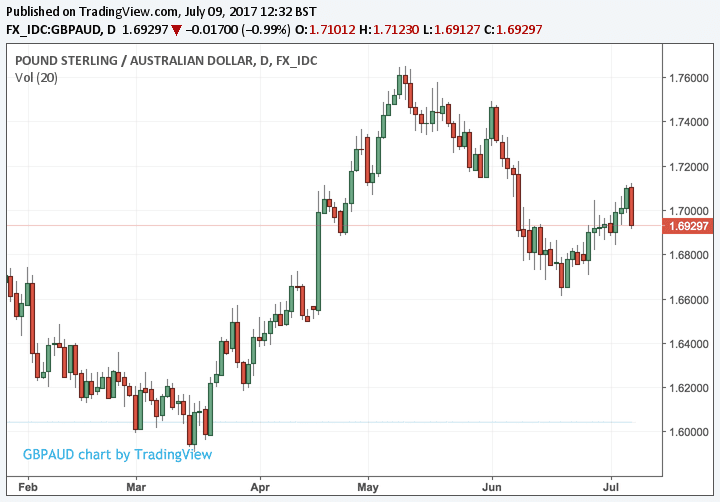Australian Dollar Tipped to Find Support on Steadying Iron Ore Prices

It’s been a mixed month-to-date (past 30 trading days) for the Australian Dollar which is stuck in the middle of the G10 field when it comes to comparitive performance.
Keeping the Aussie Dollar from registering any notable gains was the Reserve Bank of Australia (RBA) which at their monthly policy meeting opted to keep interest changes - and importantly - guidance regarding future moves unchanged.
Currently at 1.6975, the Pound to Australian Dollar exchange rate is 1.10% higher than where it was one month ago.
This suggests there is no big trend in favour of either currencies underway at present. This is good for those who need a more stable rate to plan international payments, bad for those who want either a stronger Pound or Aussie Dollar.
GBP/AUD popped from 1.6856 to around 1.70 following the RBA event.
However, the dismal manufacturing numbers on July 7 then took some shine off Sterling’s performance with the exchange rate registering a near 1% fall:
It's a bit of deadlock on GBP/AUD to be honest and I would be wary to suggest any directional move is likely near-term.
Concerning the AUD’s broader outlook we are told that it will be iron ore that could be where the excitement lies.
“Increasing supply and risks of steel-related protectionist policies may see iron ore prices move lower in the short-term. The Australian government expect prices to average at US$49.10/t in 2018, which is AUD negative,” says Viraj Patel, an analyst with ING Bank N.V. in London.
Iron ore is Australia’s largest export and therefore contributes heavily to the country’s foreign exchange earnings capability.
Evolution of this story over coming days and weeks will be key.
The good news for Aussie-bulls is that iron ore prices appear to have bottomed.
"Following a period of protracted weakness the price of iron ore rebounded dramatically las week, putting on a hefty 12% in the space of just five trading days," notes Bill McNamara, an analyst with brokers Charles Stanley in London. "This price action (which was driven by a significant increase in volumes) strongly suggests that the bottom is now in, at $54 or so."
Although given the magnitude of the move, McNamara says it would not be too surprising if there was a degree of consolidation before the rally continued.
We expect this development to keep the Aussie supported.
The Pound’s Week Ahead: A Rude Wake-up Call from Jobs Data?
Looking at the Sterling side of the equation, what the below-par manufacturing data released on Friday, July 7 told us is that data still has the power to influence moves in a currency that has been a political one for some time now.
For that reason, we will certainly be watching the big-ticket releases due in the coming week.
First-up is the BRC’s retail sales monitor due on Tuesday July 11. This isn’t a headline release and will probably not shake Sterling. BUT, it will tell us whether UK retail sales are seeing an improvement. If so, then the more important ONS retail sales figure due for release later in the month will deliver a positive surprise.
Economists are looking for the BRC to report 0.5% growth.
Wednesday brings with it employment market data - look for wage growth. Average earnings, with bonus included are forecast to rise 1.8%.
Anything worse will be bad for the Pound as it confirms momentum in the economy is headed the wrong way with inflation continuing to erode earnings power.
“The May UK labour report will probably come as a disappointment to MPC hawks banking on the Phillips Curve - that is low unemployment rates translating into higher labour costs - coming good,” says ING's Patel.
In short, the UK’s low unemployment level is not resulting in stronger pay growth and the Bank of England therefore does not have to raise interest rates to counter home-grown inflation that is a side-effect of higher pay levels.
And, it’s an interest rate rise or two that will really get the Pound moving higher.
“With the BoE tightening debate more of a 2018 story, a dovish repricing at the front-end of the UK OIS curve remains a risk to GBP in the near-term,” says Patel.












